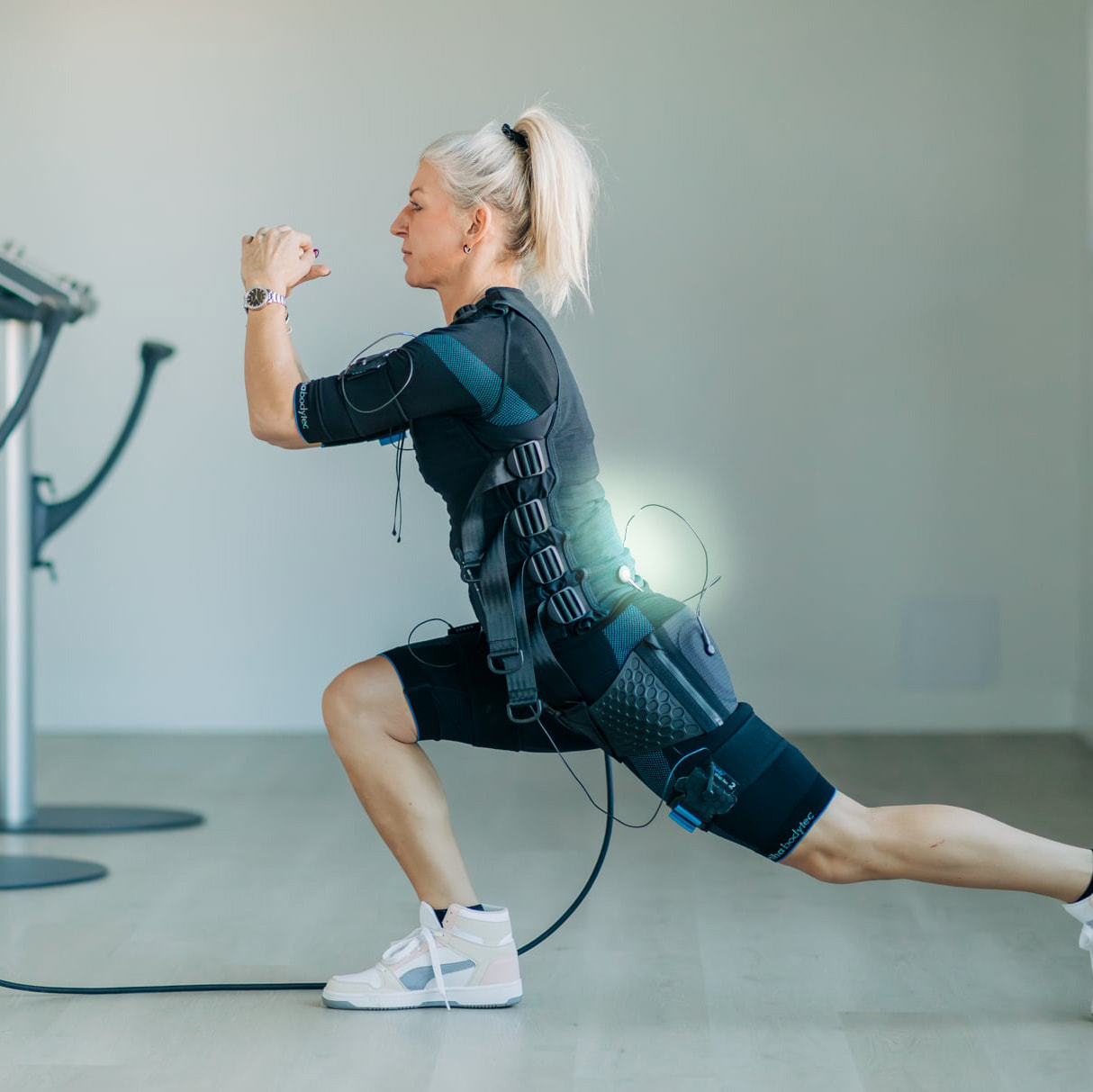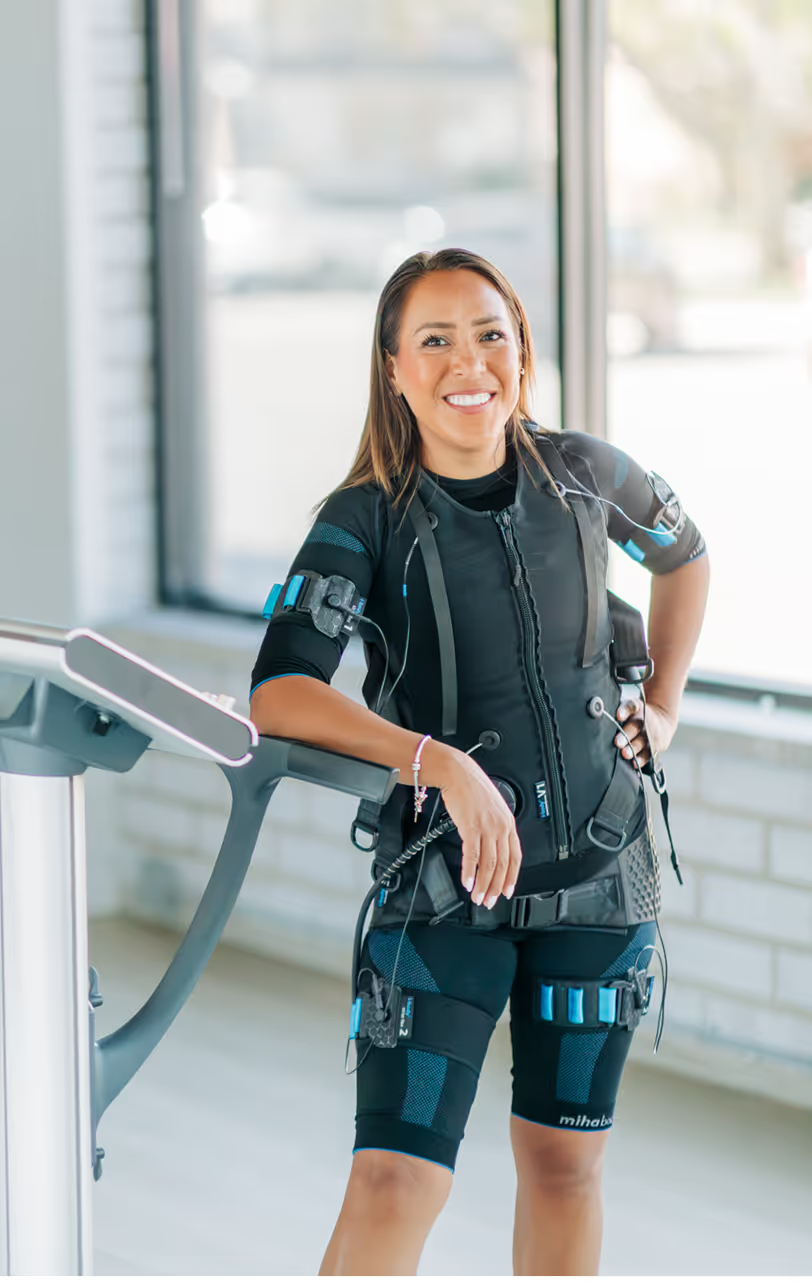Back Pain and EMS: What the Evidence Says and How to Train Safely
Back pain doesn’t have to define you. Coach-led electrical muscle stimulation in Chicago strengthens your core, reduces stiffness, and supports relief in just 20 minutes a week. Find out how it works

TL;DR
Living with a stiff, achy back isn’t a personality trait – it’s a solvable problem. If you’re short on time or traditional gym work aggravates your spine, electrical muscle stimulation (EMS) can be a joint‑friendly way to build trunk strength under a coach’s eye. It’s not a cure‑all, and it isn’t for everyone, but the research is steadily clear: done properly, EMS can reduce chronic, nonspecific low back pain and improve core strength – efficiently and safely.
First, a quick primer: EMS for muscle conditioning, not ambulances
EMS uses controlled electrical impulses to contract muscles while you perform guided movements. At Fit in 20 we use FDA‑cleared equipment for muscle conditioning – the same category the FDA calls a “powered muscle stimulator” (prescription devices with labeled indications like muscle re‑education, increasing local circulation, preventing disuse atrophy, and maintaining range of motion).
What the strongest research says about EMS and back pain
- Randomized controlled trials (RCTs): Whole‑body EMS (WB‑EMS) once weekly (~20 minutes) reduced chronic nonspecific low back pain and increased trunk‑extensor strength, compared with a non‑training control group.
- Head‑to‑head vs conventional back training: A multicentre RCT found WB‑EMS achieved similar reductions in pain intensity and gains in trunk strength as conventional back‑strengthening training – while being more time‑efficient.
- Active control comparisons: Another controlled study found WB‑EMS was at least as effective as a multimodal back-pain treatment – with just 20 minutes per week – and substantially time‑efficient.
- Growing evidence base: Systematic reviews reinforce that WB‑EMS is a safe, efficient, and effective tool for addressing nonspecific chronic low back pain in non‑athletic adults.
Why EMS can help backs that complain
- High muscle recruitment with low joint load: EMS activates many fibres at once, letting you strengthen spinal stabilisers without heavy loading – ideal when traditional lifting hurts. RCTs show trunk‑strength gains track with pain reductions.
- Consistency over intensity: Short, scheduled sessions improve adherence – and consistency is pivotal for back‑pain improvement in clinical guidelines.
Safety first: who should (and shouldn’t) use EMS
Your coach screens for contraindications and starts conservatively. Safety literature emphasises close supervision, qualified trainers, slow ramp‑up and adequate rest between early sessions.
Urgent red flags (see a clinician first) include new bowel/bladder changes, unexplained weight loss, fever, cancer with new back pain, serious trauma or progressive leg weakness – these align with major triage guidelines.
How a back-friendly EMS session is structured at Fit in 20 (Chicago)
- Screen & set expectations (5–10 min): We review your history, rule out red flags and note any movements that cause flare‑ups.
- Guided core‑focused work (15–20 min): You perform low‑range, coach‑cued movements (like anti‑rotation, hip hinge, step or reach) while the suit stimulates trunk and hips. Intensity starts conservatively and increases session‑by‑session.
- Cool‑down & plan (3–5 min): We log what felt good versus edgy, set a simple home habit (like light mobility or walking), and book your next session.
Smart progression you can trust
- Dose: Most RCTs used 1×20 min/week to start. That’s what we mirror – adding a second weekly session only when recovery is solid.
- Load progression: We raise stimulation and movement challenge separately – never together – to minimise soreness and maximise safety.
- Recovery: At least 4–7 days between sessions early on is typical in safety protocols.
Behavioral design: make relief a habit (not a hope)
- Implementation intention: “Every Tuesday at 6:30 pm, I train EMS for 20 minutes before dinner.” (Specific time and place stick.)
- Fresh‑start effect: Book your first two sessions together – momentum builds.
- Approach goals, not avoidance: We track wins – like more pain‑free standing – because visible progress boosts adherence. Modern rehab favours active coping and graded exposure, not rest.
Frequently asked questions
Is EMS good for chronic low back pain?
Yes – when supervised and dosed conservatively, trials show meaningful pain reduction and trunk‑strength improvements.
EMS vs traditional back exercises – what’s better?
They’re similarly effective; EMS can be more time‑efficient if fitting long workouts is hard.
Is EMS safe if I have a disc bulge or sciatica?
It depends. Some conditions require medical clearance. We screen thoroughly and coordinate with your healthcare provider. Don’t self‑clear.
Is this “FDA-approved”?
Devices for muscle conditioning are FDA‑cleared as powered muscle stimulators (prescription category); we use them within those bounds.
How many sessions until I feel a difference?
Many clients notice improvements in posture or stiffness within 3–6 sessions—especially at about 1 × 20 minutes per week.
Bottom line
For chronic, nonspecific back pain, supervised EMS offers a joint-friendly, time-efficient path to build trunk strength and reduce symptoms – fully aligned with active care guidelines. In Chicago and ready for an expert-led, safety-first approach? Register now to start building relief and strength you can feel.
Register for a free trial session
Experience an innovative training method that makes every moment count. Energize your body, build strength, and see how training in the suit can fit perfectly into your week.
First session free (~30 min)


.avif)

